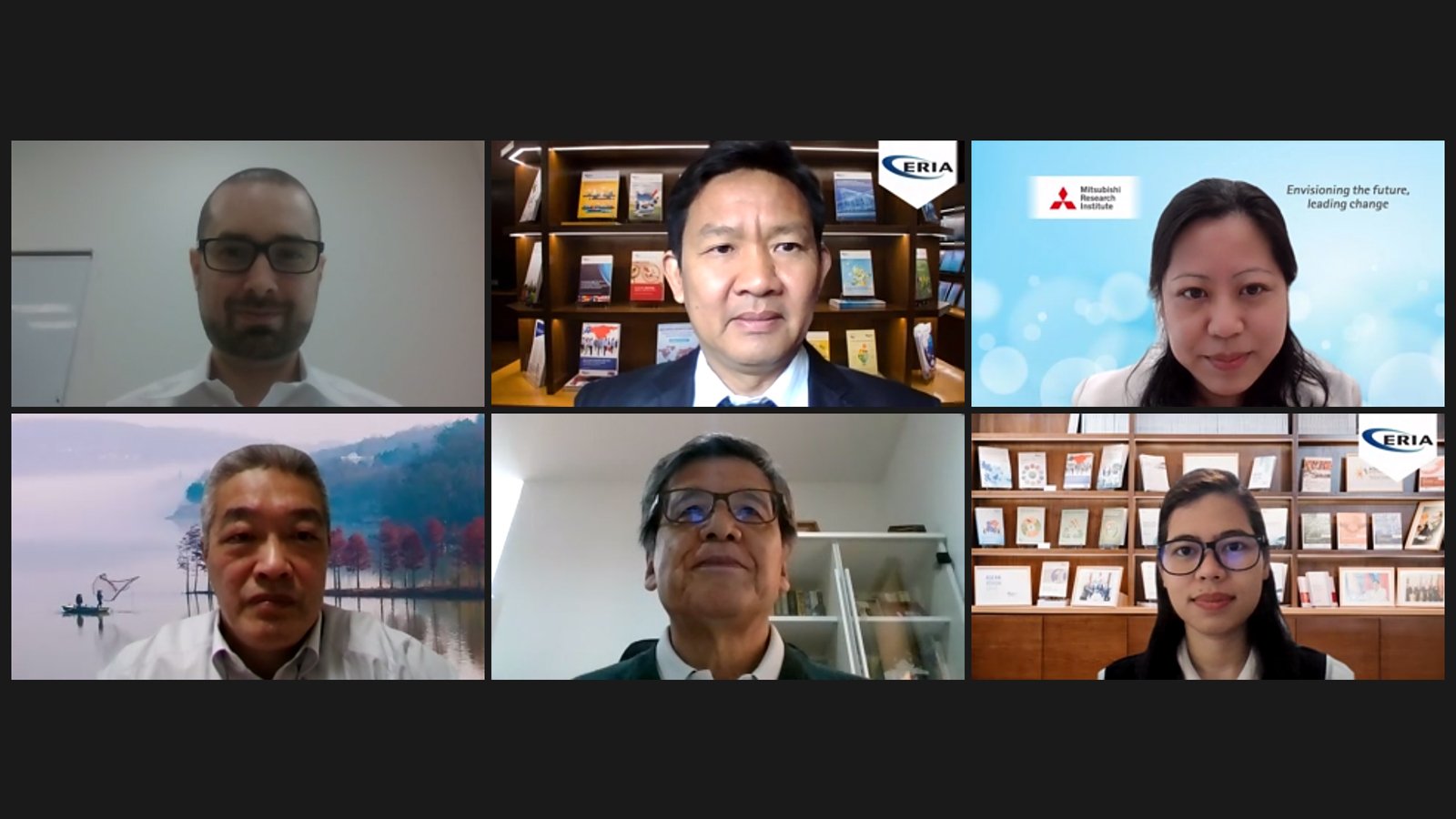CCUS Technical Workshop: Day 2-Technical Aspect of Carbon Transportation & Storage Technology
Virtual Conference, 6 October 2021: The Carbon, Capture, Utilisation and Storage (CCUS) Technical Workshop is organised by the Economic Research Institute for ASEAN and East Asia (ERIA) and the Asia CCUS Network (ACN) to bridge the knowledge gap of CCUS technology and development. The Network strives to contribute to the decarbonisation of emissions in Asia through research, training, and knowledge sharing on CCUS technologies. The event is part of a workshop series that fall under the ACN’s capacity building training pillar, encompassing one of three core missions.
Opening Remarks and Introductory Remarks
Dr Han Phoumin shared the importance and timing of the technical workshop with Asia needing to redesign a policy landscape to ensure crucial tech like CCUS can be deployed in the region. He further expressed the ACN’s hope that through capacity building training, policymakers in Asia can assist in accelerating policy developments and support for this innovation to swiftly position the region on the pathway to carbon neutrality by 2050. ‘CCUS is one of the artificial carbon sink technologies that will be capable of removing carbon in a necessary scale to fight global warming,’ he stated.
A summary from the first day of the event mentioned some of the most commonly used technology on carbon capture: solvent-based CO2 capture, solid-based CO2 capture, and membrane-based carbon capture. Nevertheless, high costs remain a barrier in CCUS deployment even though large-scale deployment of this tech is crucial to bring down prices, along with policy support. Dr Phoumin welcomed the start of the second day of the workshop titled ‘Technical Aspect of Carbon Transportation & Storage Technology’, in which he stated CO2 transportation and storage technology are ‘crucial in the CCUS value chain.’
Mrs Kikuko Shinchi offered Introductory Remarks highlighting Southeast Asia’s potential CO2 storage capacity which amounts to 170 gigatonnes with most in saline aquifers and depleted oil and gas fields. Using feasibility data from depleted oil and gas fields, Mrs Shinchi suggested that these sites could serve as an initial way to proceed with CCUS in the region. She added that whilst ASEAN has excess carbon capture storage than IEA estimates, not all storage may be feasible for use. As such, Mrs Shinchi called for further extensive research and work to ascertain the economic and technical feasibility.
Based on a study on Indonesia, the country was found to have reservoirs located near developed or already depleted gas and oil fields where access from mining plants and oil refineries, major CO2 emitters, is relatively good. As such, Mrs Shinchi encouraged the Indonesian government to take advantage of this situation, and together with the private sector, promote CCUS activities. A country study on Thailand revealed that there may be storage potential in its gas and oil fields which are on the verge of exhaustion. Similar findings on Viet Nam offer similar insights where most storage potential are found in deep saline reservoirs and its depleted oil and gas fields.
These studies indicate that some AMS possess storage potential, however, plenty of data and information are unavailable particularly in ASEAN countries without oil and gas fields. Mrs Shinchi asserted that further research on the matter remains a task that needs to be addressed going forward.
Presentations
Overview of Marine/Pipeline Transportation Technologies
Mr Ulysses Coulmas, Researcher, MRI mentioned the four methods of transporting CO2: (1) Pipelines, (2) Trains, (3) Ships, and (4) Trucks. The most common and likely mode of transportation are pipelines where there are already thousands of kilometres of pipelines around the world that are carrying oil and natural gas. Not only have pipelines proven to be an eminent part of the global energy infrastructure, but it is also the cheapest way to transport large quantities of liquids and gases. Ships or maritime vessels are the second-most likely transportation method where vessels have the potential to carry large amounts of liquified CO2. Trains and trucks can also be used for shorter distances and smaller quantities such as bringing the CO2 from the emitting site to a nearby intermediate storage site where it can be loaded to ships and the final destination.
For a CO2 value chain to have a real social and economic impact, building a comprehensive CO2 pipeline network will be integral hence Mr Coulmas cautioned that the development of CO2 transport will require large upfront capital expenditures. Onshore and offshore pipelines, injection wells, storage sites, and compressor stations are all components that need substantial investments. On the maritime end, there will be necessary investments for ships, loading and unloading facilities and intermediate storage. The disadvantage of maritime transport induces more CO2 transport emissions than pipelines due to additional energy use for liquefaction and fuel use in ships.
Mr Coulmas assessed that CCUS development continues to be highly project-based where there are no global or national-level CO2 infrastructures yet. He summarised that to create a CO2 value chain that has a realistic socio-economic impact, it is inevitable to scale up the transportation network. His research indicates that comprehensive pipeline systems would reduce apparatus costs of individual CCS projects while increasing the value of CO2 as an asset for possible utilisation. He concluded that ‘maritime vessels that can carry large volumes of CO2 will be key to connect emitting sources and injection sites over long distances and will add flexibility to the logistics of CO2.’
Overview of Storage Technologies
Dr Ziqiu Xue, Chief Researcher of Research Institute of Innovative Technology for the Earth (RITE), CO2 Storage Research Group Leader, began his presentation with a historical background of geological CO2 storage covering the US and Canada’s EOR projects as well as Norway’s Sleipner project. On geological storage, Dr Xue stipulated that around 40% to 70% of injected CO2 remains in the reservoir thus proving that the subsurface carbon storage method is safe. This method first began as part of gas field developments in 1996 and assurance monitoring over the past 25 years followed and has proven to be a safe and secure carbon storage process.
A vital part of safe geological carbon storage is monitoring which helps to reduce uncertainties about this technology and enhance process optimisation. Dr Xue stated that continued monitoring will be necessary even after a site is closed to ensure the long-term safety of the CO2 storage. As with any activity, risks are involved, however, ‘the risk must be reduced to manageable level for safety purposes.’ To counter public misunderstanding of this carbon-neutral innovation, Dr Xue finds it essential to strengthen risk communication and share further information on geological CO2 storage with local communities.
Dr Xue explained that while there is abundant knowledge on carbon storage, more research and development is needed to create tools that can cope with different geological conditions and challenges of countries across Asia. Other problems include scaling up, liability matters, and public reassurance regarding the safety of CO2 storage must also be addressed. To apply large-scale deployment of these storage technologies, Dr Xue underscored the importance for stakeholders and governments to cooperate and tackle environmental, regulatory, public acceptance, policy, government, and financial issues. Dr Xue is confident that if these aspects can come together then commercial-scale CO2 storage will be attainable.
The next step of this innovation is commercialisation where there is a growing number of CCS and CCUS projects in China, Japan, Australia, and the Middle East. Dr Xue explained that there are some projects in planning in Malaysia and Indonesia though the pace of CCS and CCUS development in Southeast Asia falls short. As such, East and Southeast Asia can collaborate with leading CCS and CCUS operators in the US and Norway to support technological development on an international scale.
Questions and Answers
What is the outlook for carbon-free maritime transport and what can we expect?
Carbon emissions reduction is a massive challenge for the whole transportation sector thus the outlook of a carbon-neutral maritime transport is linked to the fuel type of the ship. Establishing a fuel network would be a solid first step in securing CO2-free fuel. Another aspect is to secure the necessary technology which would make such plans realistic, however, financing could pose a problem. I believe carbon-free shipping transportation may be available by 2040.
What are some of the solutions to counter gas pipeline issues in Southeast Asia?
The differences in economic development and geography in Southeast Asia presents varied problems for ASEAN. Southeast Asia is mostly connected on maritime routes but lacks the network on land. Thus, it will be crucial to assess how to build a connection from the emitting sources to the storage sites by considering factors such as distance as well as surface and geological circumstances. There is no one best solution to resolve gas pipeline issues thus the approach must be on a case-by-case basis. For example, exploring reasons behind a country’s lack of gas pipelines may reveal findings such as high earthquake risks or unsuitable soil quality.
ASEAN’s effort in expanding its gas pipelines has been met with limited progress. Is a transboundary CO2 transport network in Southeast Asia possible?
Cross-country CO2 transportation among AMS is not as strong as those in the EU where the latter has a bit more schemes and regulations. Certainly, there needs to be more work on the political level to pave the way for a CO2 pipeline network. On the geological part, it is worth discussing the feasibility of connecting ASEAN countries with a pipeline with several options. I think the difficulties to make a pipeline network in ASEAN is greater than in Europe so the primary option for cross-border border transport in ASEAN would likely be ships.
Besides the environmental benefits of CCUS, what other benefits or incentives are available for industry players?
Benefits and incentives are some of the key challenges behind CCUS development. Offering more of it gives CCUS additional value and enhances deployment opportunities. The environmental benefit of this technology bodes well for companies as it provides a social impact incentive during a time of increased political and social pressure on firms to reduce emissions. Several governments have included CCUS in their green growth strategy as they look to achieve their environmental and economic targets. The idea is to promote CCUS as an investment project that brings new businesses and industries and more employment. Ultimately, to bring down the costs of CCUS, the rewards must be bigger to encourage further investments thus capturing as much carbon dioxide as possible.
Can you elaborate on the Japanese technical requirements to demonstrate permanent storage? Are there any industry standards on CO2 storage monitoring and verification on a general scale?
Based on our pilot project, lab studies and fields projects must go hand-in-hand as it helps governments to understand the long-term safety of CO2 geological storage. Such insights can assist policymakers in determining a carbon tax rate that countries in Asia like Japan currently does not have. As for the industry standards, there are no industry regulations or standards for CO2 storage at the current moment.
Relive the Webinar
Mr Ulysses Coulmas’ Presentation
Dr Ziqiu Xue’s Presentation

